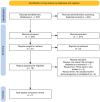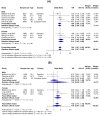The relationship between low prolactin and type 2 diabetes
- PMID: 38760578
- PMCID: PMC11624211
- DOI: 10.1007/s11154-024-09886-w
The relationship between low prolactin and type 2 diabetes
Abstract
Prolactin (PRL) is secreted throughout life in men and women. At elevated levels, its physiological role in pregnancy and lactation, and pathological effects, are well known. However clinical implications of low circulating PRL are not well established. We conducted a meta-analysis to examine the relationship between low PRL levels and type 2 diabetes. Five papers included cross-sectional studies comprising 8,720 men (mean age range 51.4-60 years) and 3,429 women (49.5-61.6 years), and four papers included cohort studies comprising 2,948 men (52.1-60.0 years) and 3,203 women (49.2-60.1 years). Individuals with pregnancy, lactation and hyperprolactinemia, drugs known to alter circulating PRL levels, or pituitary diseases had been excluded. Although most studies used quartiles to categorize PRL groups for analysis, PRL cut-off values (all measured by chemiluminescence immunoassay) were variably defined between studies: the lowest PRL quartiles ranged from 3.6 ng/ml to 7.2 ng/ml in men and between 4.5 ng/ml to 8 ng/ml in women; and the highest PRL quartiles ranged from 6.9 ng/ml to 13 ng/ml in men and 9.6 ng/ml to 15.8 ng/ml in women. Type 2 diabetes was defined variably using self-reported physician's diagnosis, fasting blood glucose, oral glucose tolerance test or glycated hemoglobin (HbA1C). In cross-sectional studies, compared to individuals in the highest PRL groups (reference), those in the lowest PRL groups had greater risk of type 2 diabetes both in men: odds ratio (OR) and 95% confidence interval = 1.86 (1.56-2.22) and in women: OR = 2.15 (1.63-2.85). In cohort studies, women showed a significant association between low PRL and type 2 diabetes: OR = 1.52 (1.02-2.28) but not men: OR = 1.44 (0.46-4.57). Relatively low heterogeneity was observed (I2 = 25-38.4%) for cross-sectional studies, but higher for cohort studies (I2 = 52.8-79.7%). In conclusion, low PRL is associated with type 2 diabetes, but discrepancy between men and women in the relationship within cohort studies requires further research.
Keywords: Hypoprolactinemia; Meta-analysis; Sex-specific analysis.
© 2024. The Author(s).
Conflict of interest statement
Declarations. Competing interests: The authors declare no competing interests. Conflict of interest statement: The authors declare no conflicts of interest.
Figures


References
-
- Bernard V, Young J, Binart N. Prolactin - a pleiotropic factor in health and disease. Nat Rev Endocrinol. 2019;15(6):356–65. 10.1038/s41574-019-0194-6. - PubMed
-
- Freeman ME, Kanyicska B, Lerant A, Nagy G. Prolactin: structure, function, and regulation of secretion. Physiol Rev. 2000;80(4):1523–631. 10.1152/physrev.2000.80.4.1523. - PubMed
Publication types
MeSH terms
Substances
LinkOut - more resources
Full Text Sources
Medical
Miscellaneous

